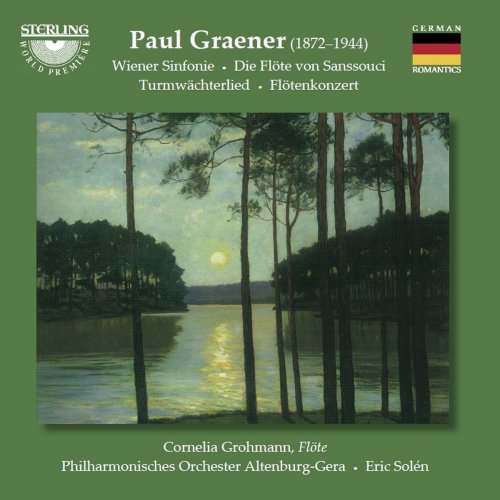
Philharmonisches Orchester Altenburg-Gera - Graener: Orchestral Works (2010)
BAND/ARTIST: Philharmonisches Orchester Altenburg-Gera
- Title: Graener: Orchestral Works
- Year Of Release: 2010
- Label: Sterling Records
- Genre: Classical
- Quality: FLAC (tracks+booklet)
- Total Time: 72:42 min
- Total Size: 319 MB
- WebSite: Album Preview
Tracklist:
01. Wiener Sinfonie in F Major, Op. 110: I. Allegro moderato
02. Wiener Sinfonie in F Major, Op. 110: II. Andante sostenuto
03. Wiener Sinfonie in F Major, Op. 110: III. Con moto
04. Die Flöte von Sanssouci, Op. 88: I. Introduktion und Sarabande
05. Die Flöte von Sanssouci, Op. 88: II. Gavotte
06. Die Flöte von Sanssouci, Op. 88: III. Air
07. Die Flöte von Sanssouci, Op. 88: IV. Rigaudon
08. Turmwächterlied, Op. 107
09. Flötenkonzert, Op. 116: I. Un poco allegro ma moderato
10. Flötenkonzert, Op. 116: II. Andantino
11. Flötenkonzert, Op. 116: III. Rondo 'Freut Euch des Lebens'
01. Wiener Sinfonie in F Major, Op. 110: I. Allegro moderato
02. Wiener Sinfonie in F Major, Op. 110: II. Andante sostenuto
03. Wiener Sinfonie in F Major, Op. 110: III. Con moto
04. Die Flöte von Sanssouci, Op. 88: I. Introduktion und Sarabande
05. Die Flöte von Sanssouci, Op. 88: II. Gavotte
06. Die Flöte von Sanssouci, Op. 88: III. Air
07. Die Flöte von Sanssouci, Op. 88: IV. Rigaudon
08. Turmwächterlied, Op. 107
09. Flötenkonzert, Op. 116: I. Un poco allegro ma moderato
10. Flötenkonzert, Op. 116: II. Andantino
11. Flötenkonzert, Op. 116: III. Rondo 'Freut Euch des Lebens'
Berlin was Paul Graener’s city of birth although over a longish he career he also lived in London, Vienna, Dresden, Berlin and Munich. He joined the Nazi Party in 1933 and rode high in the Reichsmusikkammer. His Berling flat and most of his possessions were destroyed by bombing in 1944. He died in Salzburg.
He wrote eight operas the first being The Faithful Sentry which was premiered in 1899 and the last Der Prinz von Homburg (1935). There are four String Quartets (1920-28) and some 130 songs. The orchestral works include: Sinfonietta for Strings and Harp (1910), Symphony in D Minor Schmied Schmerz (1912), Concerto for Cello and Chamber Orchestra (1927) and the Variationen über Prinz Eugen (1939).
His music is plush and attains a certain grandeur, complacency and repletion in the Wiener Sinfonie. Its style is roundedly Straussian with woodwind birdsong and even the occasional Mahlerian echo. The tenderly romantic aspects of Schumann’s music can be felt in the middle movement of the Wiener Sinfonie. The finale has a grunting, heavy-booted euphoric emphasis - rugged and imposing. The symphony was premiered in 1941 by Hans Knappertsbusch with the Berlin Philharmonic. The Die Flöte von Sanssouci is a suite for flute and orchestra of four movements with baroque titles. The weighty Regerian textures provide a carpet for Graener’s dialogue between Bachian discipline and late-romantic excess. A ringing harpsichord features in the work’s Gavotte and Air. While the final Rigaudon looks forward to the Mahlerian sauntering of the first movement of the Wiener Sinfonie. The Turmwächterlied is a work of sable expression and shaded preoccupation. It abjures neo-Bachian density and instead embraces a sort of suffocating Germanic Respighian romance. The score for Turmwächterlied is prefaced by Goethe’s poem Zum sehen geboren from Part II of Faust. The Flute Concerto is a gracious lilting and darting creature - Le Bourgeois Gentilhomme meets Ravel’s Le Tombeau de Couperin.
He wrote eight operas the first being The Faithful Sentry which was premiered in 1899 and the last Der Prinz von Homburg (1935). There are four String Quartets (1920-28) and some 130 songs. The orchestral works include: Sinfonietta for Strings and Harp (1910), Symphony in D Minor Schmied Schmerz (1912), Concerto for Cello and Chamber Orchestra (1927) and the Variationen über Prinz Eugen (1939).
His music is plush and attains a certain grandeur, complacency and repletion in the Wiener Sinfonie. Its style is roundedly Straussian with woodwind birdsong and even the occasional Mahlerian echo. The tenderly romantic aspects of Schumann’s music can be felt in the middle movement of the Wiener Sinfonie. The finale has a grunting, heavy-booted euphoric emphasis - rugged and imposing. The symphony was premiered in 1941 by Hans Knappertsbusch with the Berlin Philharmonic. The Die Flöte von Sanssouci is a suite for flute and orchestra of four movements with baroque titles. The weighty Regerian textures provide a carpet for Graener’s dialogue between Bachian discipline and late-romantic excess. A ringing harpsichord features in the work’s Gavotte and Air. While the final Rigaudon looks forward to the Mahlerian sauntering of the first movement of the Wiener Sinfonie. The Turmwächterlied is a work of sable expression and shaded preoccupation. It abjures neo-Bachian density and instead embraces a sort of suffocating Germanic Respighian romance. The score for Turmwächterlied is prefaced by Goethe’s poem Zum sehen geboren from Part II of Faust. The Flute Concerto is a gracious lilting and darting creature - Le Bourgeois Gentilhomme meets Ravel’s Le Tombeau de Couperin.
As a ISRA.CLOUD's PREMIUM member you will have the following benefits:
- Unlimited high speed downloads
- Download directly without waiting time
- Unlimited parallel downloads
- Support for download accelerators
- No advertising
- Resume broken downloads


